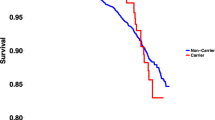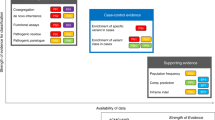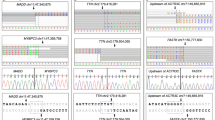Abstract
Marked prolongation of the QT interval and polymorphic ventricular tachycardia following medication (drug-induced long QT syndrome, diLQTS) is a severe adverse drug reaction (ADR) that phenocopies congenital long QT syndrome (cLQTS) and is one of the leading causes for drug withdrawal and relabeling. We evaluated the frequency of rare non-synonymous variants in genes contributing to the maintenance of heart rhythm in cases of diLQTS using targeted capture coupled to next-generation sequencing. Eleven of 31 diLQTS subjects (36%) carried a novel missense mutation in genes with known congenital arrhythmia associations or with a known cLQTS mutation. In the 26 Caucasian subjects, 23% carried a highly conserved rare variant predicted to be deleterious to protein function in these genes compared with only 2–4% in public databases (P<0.003). We conclude that the rare variation in genes responsible for congenital arrhythmia syndromes is frequent in diLQTS. Our findings demonstrate that diLQTS is a pharmacogenomic syndrome predisposed by rare genetic variants.
This is a preview of subscription content, access via your institution
Access options
Subscribe to this journal
Receive 6 print issues and online access
$259.00 per year
only $43.17 per issue
Buy this article
- Purchase on Springer Link
- Instant access to full article PDF
Prices may be subject to local taxes which are calculated during checkout
Similar content being viewed by others
References
Selzer A, Wray HW . Quinidine syncope. Paroxysmal ventricular fibrillation occurring during treatment of chronic atrial arrhythmias. Circulation 1964; 30: 17–26.
Koster RW, Wellens HJ . Quinidine-induced ventricular flutter and fibrillation without digitalis therapy. Am J Cardiol 1976; 38: 519–523.
Kemper AJ, Dunlap R, Pietro DA . Thioridazine-induced torsade de pointes. Successful therapy with isoproterenol. JAMA 1983; 249: 2931–2934.
Wilke RA, Lin DW, Roden DM, Watkins PB, Flockhart D, Zineh I et al. Identifying genetic risk factors for serious adverse drug reactions: current progress and challenges. Nat Rev Drug Discov 2007; 6: 904–916.
Torp-Pedersen C, Møller M, Bloch-Thomsen PE, Køber L, Sandøe E, Egstrup K et al. Dofetilide in patients with congestive heart failure and left ventricular dysfunction. Danish Investigations of Arrhythmia and Mortality on Dofetilide Study Group. N Engl J Med 1999; 341: 857–865.
Murray KT . Ibutilide. Circulation 1998; 97: 493–497.
Soyka LF, Wirtz C, Spangenberg RB . Clinical safety profile of sotalol in patients with arrhythmias. Am J Cardiol 1990; 65: 74A–81A;, discussion 82A-83A.
Roden DM . Cellular basis of drug-induced torsades de pointes. Br J Pharmacol 2008; 154: 1502–1507.
Roden DM, Viswanathan PC . Genetics of acquired long QT syndrome. J Clin Invest 2005; 115: 2025–2032.
Roden DM, Altman RB, Benowitz NL, Flockhart DA, Giacomini KM, Johnson JA et al. Pharmacogenomics: challenges and opportunities. Ann Intern Med 2006; 145: 749–757.
Giacomini KM, Brett CM, Altman RB, Benowitz NL, Dolan ME, Flockhart DA et al. The pharmacogenetics research network: from SNP discovery to clinical drug response. Clin Pharmacol Ther 2007; 81: 328–345.
Mallal S, Phillips E, Carosi G, Molina J-M, Workman C, Tomazic J et al. HLA-B*5701 screening for hypersensitivity to abacavir. N Engl J Med 2008; 358: 568–579.
Link E, Parish S, Armitage J, Bowman L, Heath S, Matsuda F et al. SLCO1B1 variants and statin-induced myopathy--a genomewide study. N Engl J Med 2008; 359: 789–799.
Motsinger-Reif AA, Jorgenson E, Relling MV, Kroetz DL, Weinshilboum R, Cox NJ et al. Genome-wide association studies in pharmacogenomics: successes and lessons. Pharmacogenet, Genomics; advance online publication, 15 July 2010 (e-pub ahead of print).
Newton-Cheh C, Eijgelsheim M, Rice KM, de Bakker PIW, Yin X, Estrada K et al. Common variants at ten loci influence QT interval duration in the QTGEN Study. Nat Genet 2009; 41: 399–406.
Pfeufer A, Sanna S, Arking DE, Müller M, Gateva V, Fuchsberger C et al. Common variants at ten loci modulate the QT interval duration in the QTSCD Study. Nat Genet 2009; 41: 407–414.
Kaab S, Ritchie M, Crawford D, Sinner M, Kannankeril P, Wilde A et al. Genome-wide association study identifies novel genomic regions associated with drug-induced long Qt syndrome. Circulation 2009; 120: S580.
Volpi S, Heaton C, Mack K, Hamilton JB, Lannan R, Wolfgang CD et al. Whole genome association study identifies polymorphisms associated with QT prolongation during iloperidone treatment of schizophrenia. Mol Psychiatry 2009; 14: 1024–1031.
Wei J, Yang I, Tapper A, Murray K, Viswanathan P, Rudy Y et al. KCNE1 polymorphism confers risk of drug-induced long QT syndrome by altering kinetic properties of IKs potassium channels. Circulation 1999; 100: I–495.
Ackerman MJ, Mohler PJ . Defining a new paradigm for human arrhythmia syndromes: phenotypic manifestations of gene mutations in ion channel- and transporter-associated proteins. Circ Res 2010; 107: 457–465.
Priori SG, Napolitano C, Schwartz PJ . Low penetrance in the long-QT syndrome: clinical impact. Circulation 1999; 99: 529–533.
Yang P, Kanki H, Drolet B, Yang T, Wei J, Viswanathan PC et al. Allelic variants in long-QT disease genes in patients with drug-associated torsades de pointes. Circulation 2002; 105: 1943–1948.
Paulussen ADC, Gilissen RAHJ, Armstrong M, Doevendans PA, Verhasselt P, Smeets HJM et al. Genetic variations of KCNQ1, KCNH2, SCN5A, KCNE1, and KCNE2 in drug-induced long QT syndrome patients. J Mol Med 2004; 82: 182–188.
Itoh H, Sakaguchi T, Ding W-G, Watanabe E, Watanabe I, Nishio Y et al. Latent genetic backgrounds and molecular pathogenesis in drug-induced long-QT syndrome. Circ Arrhythm Electrophysiol 2009; 2: 511–523.
Bush WS, Crawford DC, Alexander C, George Jr AL, Roden DM, Ritchie MD . Genetic variation in the rhythmonome: ethnic variation and haplotype structure in candidate genes for arrhythmias. Pharmacogenomics 2009; 10: 1043–1053.
Priori SG, Napolitano C, Tiso N, Memmi M, Vignati G, Bloise R et al. Mutations in the cardiac ryanodine receptor gene (hRyR2) underlie catecholaminergic polymorphic ventricular tachycardia. Circulation 2001; 103: 196–200.
London B, Michalec M, Mehdi H, Zhu X, Kerchner L, Sanyal S et al. Mutation in glycerol-3-phosphate dehydrogenase 1 like gene (GPD1-L) decreases cardiac Na+ current and causes inherited arrhythmias. Circulation 2007; 116: 2260–2268.
Li H, Durbin R . Fast and accurate short read alignment with Burrows-Wheeler transform. Bioinformatics 2009; 25: 1754–1760.
McKenna A, Hanna M, Banks E, Sivachenko A, Cibulskis K, Kernytsky A et al. The Genome Analysis Toolkit: A MapReduce framework for analyzing next-generation DNA sequencing data. Genome Res 2010; 20: 1297–1303.
DePristo MA, Banks E, Poplin R, Garimella KV, Maguire JR, Hartl C et al. A framework for variation discovery and genotyping using next-generation DNA sequencing data. Nat Genet 2011; 43: 491–498.
Consortium T1000 GP. A map of human genome variation from population-scale sequencing. Nature 2010; 467: 1061–1073.
SeattleSeq Annotation [Internet]. Available from: http://gvs.gs.washington.edu/SeattleSeqAnnotation/HelpAbout.jsp [cited 11 November 2010]..
Glusman G, Caballero J, Mauldin D, Hood L, Roach J KAVIAR: an accessible system for testing SNV novelty. Bioinformatics (Oxford, England)..
Felsenstein J, Churchill GA . A Hidden Markov Model approach to variation among sites in rate of evolution. Mol Biol Evol 1996; 13: 93–104.
Cooper GM, Stone EA, Asimenos G, Green ED, Batzoglou S, Sidow A . Distribution and intensity of constraint in mammalian genomic sequence. Genome Res 2005; 15: 901–913.
Adzhubei IA, Schmidt S, Peshkin L, Ramensky VE, Gerasimova A, Bork P et al. A method and server for predicting damaging missense mutations. Nat Methods 2010; 7: 248–249.
Kumar P, Henikoff S, Ng PC . Predicting the effects of coding non-synonymous variants on protein function using the SIFT algorithm. Nat Protoc 2009; 4: 1073–1081.
Fenichel RR, Malik M, Antzelevitch C, Sanguinetti M, Roden DM, Priori SG et al. Drug-induced torsades de pointes and implications for drug development. J Cardiovasc Electrophysiol 2004; 15: 475–495.
Benjamin EJ, Rice KM, Arking DE, Pfeufer A, van Noord C, Smith AV et al. Variants in ZFHX3 are associated with atrial fibrillation in individuals of European ancestry. Nat Genet 2009; 41: 879–881.
Roden DM . Long QT syndrome: reduced repolarization reserve and the genetic link. J Intern Med 2006; 259: 59–69.
Acknowledgements
We thank the NHLBI GO Exome Sequencing Project and its ongoing studies that produced and provided exome variant calls for comparison: the Lung GO Sequencing Project (HL-102923), the WHI Sequencing Project (HL-102924), the Broad GO Sequencing Project (HL-102925), the Seattle GO Sequencing Project (HL-102926) and the Heart GO Sequencing Project (HL-103010). We also thank Kris Norris for patient enrollment, Christie Ingram for project management, Eric Torstenson for C++ programming and Laura Short in the Sanger sequencing core facility. Funding for this study was provided by U01 HL65962 and GM007569 from the National Institutes of Health and by a trans-Atlantic network alliance grant from the Fondation Leducq (‘Preventing Sudden Cardiac Death’).
Author information
Authors and Affiliations
Corresponding author
Ethics declarations
Competing interests
Drs George and Roden have received royalties for a US Letters Patent No. 6 458 542, issued 1 October 2002 for ‘Method of Screening for Susceptibility to Drug-Induced Cardiac Arrhythmia’.
Additional information
Supplementary Information accompanies the paper on the The Pharmacogenomics Journal website
Supplementary information
Rights and permissions
About this article
Cite this article
Ramirez, A., Shaffer, C., Delaney, J. et al. Novel rare variants in congenital cardiac arrhythmia genes are frequent in drug-induced torsades de pointes. Pharmacogenomics J 13, 325–329 (2013). https://doi.org/10.1038/tpj.2012.14
Received:
Revised:
Accepted:
Published:
Issue Date:
DOI: https://doi.org/10.1038/tpj.2012.14
Keywords
This article is cited by
-
Genetics of myocardial interstitial fibrosis in the human heart and association with disease
Nature Genetics (2023)
-
Genetics and genomics of arrhythmic risk: current and future strategies to prevent sudden cardiac death
Nature Reviews Cardiology (2021)
-
Impact of New Genomic Technologies on Understanding Adverse Drug Reactions
Clinical Pharmacokinetics (2016)
-
Pharmacogenomic and clinical data link non-pharmacokinetic metabolic dysregulation to drug side effect pathogenesis
Nature Communications (2015)
-
Clinical Association Between Pharmacogenomics and Adverse Drug Reactions
Drugs (2015)



